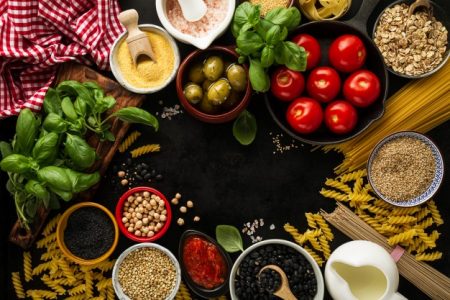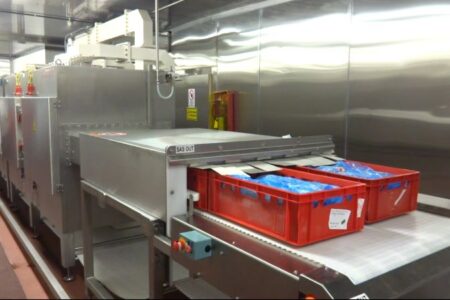Chain reaction

 Dr Chris Knight, head of agriculture at Campden BRI, explains the importance of safeguarding the links in the food chain
Dr Chris Knight, head of agriculture at Campden BRI, explains the importance of safeguarding the links in the food chain
Traceability has become something of a buzzword in the food industry following a number of food safety incidents over the years. It is a widely used term and is one of those broad concepts, like quality, for which there are many definitions and applications.
Defining traceability
There is no single, universally accepted definition or system of traceability; it depends on many factors including the nature of the product and production operation.
The EU defines traceability as ‘the ability to trace and follow a food, feed, food-producing animal or substance intended to be, or expected to be, incorporated into a food or feed, through all stages of production, processing and distribution’.
In commercial practice, traceability systems usually also include information about what has happened to the food or feed (ie its processing history) as well as where it came from and who it was sent to.
For example, the British Retail Consortium (BRC) in the Global Standard for Food safety defines traceability as ‘the ability to trace all raw material product lots (including packaging) from their supplier through all stages of processing and dispatch to their customer and vice versa’. Traceability identifies the path from which a product has originated to the customers to whom it has been supplied, and consists of an interlinking chain of records.
Depending on the nature of the business, traceability may seek to achieve a variety of objectives, such as freedom from allergens, organic status and compliance with religious requirements. In many cases, however, it will be more generic, and must be robust enough to deal with an unexpected issue when it arises – for example, the presence of an illegal additive in an ingredient.
When problems arise with a particular product, it is vital to know which batches are affected, so that suitable steps can be taken to remove the product from the market, while not unnecessarily removing unaffected products. The basis for this is a robust traceability system.
The development and implementation of a traceability system, based on recognised principles and full commitment from management and personnel, provides assurance that a food (or feed) operation has the capability to trace product externally (supplier/customer traceability – the one down/one up approach) and internally (process traceability) as applicable.
Legal requirements
Traceability has a legal framework in many countries, including, for example, the EU, USA and Japan. In the EU, Regulation (EC) 178/2002 requires traceability to be established at all stages of the food chain and all food and feed businesses within the EU are required to:
- Identify the suppliers of food, feed, food-producing animals and ingredients to their businesses
- Identify the businesses to which products have been supplied
- Maintain appropriate records and ensure that such information is made available to competent authorities on demand
The legislation also states that food businesses must initiate the withdrawal and recall of unsafe food and inform consumers of the reasons for the recall. Food businesses must also notify the Food Standards Agency (FSA) of any withdrawals and recalls.
The EU legal requirements apply to any business that trades in food at all stages of the food chain. This includes primary producers, manufacturers, wholesalers, retailers, transporters,
distributors and those dealing in the purchase and sale of bulk commodities, even if their supplier is not within the EU.
The requirements do not, however, extend to suppliers in third countries. Food business operators such as retailers do not have to identify the immediate customers when they are final consumers, since consumers are not food businesses.
In addition, Regulation (EC) 852/2004 requires food businesses to inform the FSA or other official agency, to know about every food business under their control. They must also be informed about any changes to a food business. Changes may include: a change of ownership or address, a change in the type of food being handled or a change in the amount of food being produced.
Traceability elements
Traceability systems have four key elements:
- Supplier traceability – enables the source of all raw materials (including ingredients, primary packaging and production/processing aids) to be identified and traced
- Process traceability – enables the identity of all raw materials and process records for
each product, i.e. the processing history
- Customer traceability – enables the customer for each finished product to be identified
- Efficient documentation and record keeping
Although regulations, international standards and commercial standards require traceability systems, none is prescriptive in the way they are to be achieved, mainly because there are so many options available. This issue highlights the practical difficulties involved in designing a robust traceability system.
In order to address this, in 2009 Campden BRI published a guideline (Guideline 60 – Traceability in the Food and Feed Chain) that outlines the general principles and basic system requirements for the design and implementation of a traceability system, with special reference to food safety and to legal and commercial requirements in the European Union.
More recently, Campden BRI released a Traceability Standard that outlines the requirements for a traceability system design and its implementation. The Standard not only defines the components of a traceability system but also includes the indicators of good practice for each component, and provides evidence that systems operate as specified.
Traceability advantages
As food production and distribution systems become more interdependent and integrated and increasingly more globalised, and outbreaks of foodborne illnesses are extensively covered in the media, awareness of the need for accurate, efficient and robust traceability systems is greater than ever.
One of the key benefits of a robust traceability system is the ability to quickly isolate and identify sources of contamination and in turn, conduct a targeted withdrawal or recall. This avoids having tainted or unsafe products in the food chain and safeguards consumers’ health. It also avoids tarnishing a food business’ reputation that could have a significant financial impact for both producers and retailers.
Often, traceability is viewed solely as a cost and compliance issue but it can actually mean that food businesses gain a competitive edge over rival firms and benefit from the opportunity to improve supply chain processes. In fact, traceability can be a factor for major retailers deciding what products to stock. For producers of premium foods or retailers looking to differentiate own label brands, full traceability guarantees quality and authenticity to the consumer.
Traceability not only ensures food quality but builds consumers’ trust by making the supply chain more transparent. Some studies suggest that consumers may be willing to pay more for safe and traceable food and a Korean study found that consumers were willing to pay a premium for traceable food and to purchase it with greater confidence.
Need for maintenance
Food operations throughout the food chain (farm to shop) are dynamic organisations. Processes, production environment and products themselves are likely to change with time. It is therefore important that traceability systems are regularly maintained. Indeed, if a traceability system is to continue to be effective, it must be continually reviewed and updated to reflect any changed situation.
Where changes are made to the traceability system, the need for verification to ensure that any changes have been correctly implemented in the food operation should be considered.
Records of the changes made to the traceability system over time must also be maintained. Campden BRI recommends that a system of controlled amendment be used. This will provide evidence of what changed, when it changed and why it changed.



